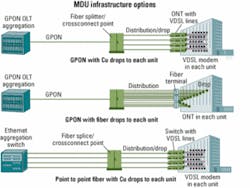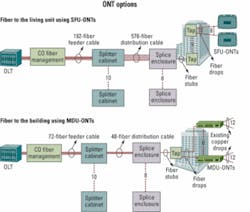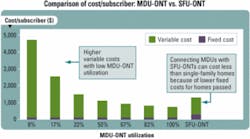Choices determine expansion of FTTP to multiple-dwelling units
by Sayeed Rashid
To date FTTH roll-outs have focused on single-family homes-but multiple-dwelling units (MDUs) represent a large market segment. Roughly 20% of the potential FTTH customers live in MDUs in the U.S.
For service providers, this is a big part of the customer base with huge revenue potential. For MDU owners, FTTH represents the best technology for broadband services and can increase property values. For consumers living in MDUs, having access to FTTH means better broadband services at more competitive prices and the ability to enjoy newer services that can only be delivered over fiber access. The need to connect MDUs with fiber access is clear, but the technical and economic choices require careful study for successful deployment.
There are many ways MDUs can be connected to the FTTH network. Most of the deployments to date have used an optical terminal at the building basement and copper drops to each apartment. Fiber all the way to the apartment or living unit (LU), however, is becoming increasingly more feasible as more bend-insensitive fiber with lower cost becomes available. The key implementation choices to address MDUs can be grouped broadly as follows (Fig. 1).
PON with copper drops. A GPON can be used to serve MDUs. In this network model, a single fiber is split to connect many MDU buildings to an optical line terminal (OLT) in the central office (CO). The feeder fiber is brought close to a cluster of buildings that need service and a passive optical splitter is used to split the signal. Each building is then connected via an optical network terminal (ONT). The ONT terminates the distribution fiber and connects each living unit with copper interfaces. Ethernet-based VDSL2 is the dominant access scheme to connect living units over copper. VDSL2 has the advantage of delivering high speed, up to 100 Mbits/sec, for the relatively short distances involved in MDUs.
PON with fiber drops. There are markets where, instead of using the existing in-building copper, a fiber drop to each apartment or living unit makes more economic sense. In this model, the fiber distribution network extends into the building. Fiber taps are used in different parts or floors of the MDU building to drop individual fiber drops directly to each LU.
Point-to-point (P2P) Ethernet. In this network model, separate fibers are used to connect each MDU building to an Ethernet switch in the CO. The Ethernet switch performs traffic aggregation for a large number of MDUs served from that CO. The fiber is terminated in the building using an Ethernet switch with copper interfaces and in some cases multimode fiber. The copper interfaces used to be ATM-based ADSL2+ or VDSL. Today, as in the PON model, Ethernet-based VDSL2 is the predominant access scheme.
There are several key technical issues that must be addressed to ensure successful MDU implementations. Consideration of these issues helps sort out the required network model.
Backhaul or aggregation bandwidth. When traffic from several users is aggregated using an ONT or Ethernet switch in the MDU, backhaul bandwidth can be a bottleneck regardless of the network model used. The higher the service data rates and larger the number of LUs served by the Ethernet switch or ONT, the more backhaul bandwidth is required.
If a P2P model is used, a minimum of a Gigabit Ethernet (GbE) uplink is required. GPON, with 2.5-Gbit/sec capacity downstream and 1.2-Gbit/sec upstream, can also deliver the capacity needed for the typical case where up to 24 LUs are served using one aggregation device. For example, with 12 LUs and 50% take rate, each user running VDSL2 at 50 Mbits/sec down and 20 Mbits/sec up, a GbE uplink or GPON uplink requires no concentration of traffic at the ONT or the Ethernet switch in the MDU building.
However, the split ratio in GPON should be kept low (e.g., 1:8) and adequate uplink capacity at the CO in the P2P model should be provisioned. As more users are pooled together, the statistical gain achievable grows larger. It is possible to have higher than a 1:8 split ratio or more LUs connected when bursty data traffic is involved. Conversely, when the backhaul capacity is increased, it may be possible to offer disproportionately higher speeds for data services.
Line bandwidth scalability. Line bandwidth determines the maximum possible service rate the end customer could receive. VDSL2 pushes that maximum to around 100 Mbits/sec, but with fiber to the LU, line bandwidth can be a lot higher. In the case of GPON, the line bandwidth can be as high as 2.5 Gbits/sec downstream and 1.2 Gbits/sec upstream. Although several users share a common feeder fiber and no one can have access to all of the PON bandwidth for too long, they can potentially burst traffic at the PON rate.
Similarly, with P2P each user can potentially burst traffic at 100 Mbits/sec (i.e., Fast Ethernet link rate), but not for too long as they are limited by the uplink capacity. While VDSL2 may provide sufficient bandwidth today, fiber to the LU provides scalability for future services requiring more bandwidth.
Quality of service (QoS) and service provision. Since MDUs include many subscribers in a single building, the access network elements (i.e., MDU-ONT or Ethernet switch, OLT, etc.) need to support scalability in terms of traffic queues and traffic scheduling for QoS and addressable service interfaces. An MDU-ONT or Ethernet switch with VDSL2 interfaces will typically aggregate subscribers in up to 24 LUs. Each subscriber can be provisioned for voice, data, and video services. These services are further aggregated in the access node, resulting in tens of thousands of separate traffic streams that need to be queued and scheduled appropriately to ensure QoS.
In addition the service traffic has to be uniquely identifiable for routing/forwarding through the access network. The selected network elements must be able to scale to support triple-play services to such a large number of subscribers and maintain service quality.
Implementing video. Video has to be part of the service mix for the MDU market; implementing it can present unique challenges. For single-family units (SFUs), video can be implemented in GPON using a separate video wavelength (i.e., 1,550 nm) that carries RF video over the same fiber. It can also be implemented using IP encapsulated video packets along with data packets over the same wavelength in GPON or in P2P network models.
Distribution of RF video within the building when existing copper is used for access to the LUs requires access to in-building coax. In-building coax can be under the control of cable TV operators because of existing long-term contracts between the building owner and cable TV operator. Telco access to the in-building coax can be a challenge and has to be negotiated with MDU owners.
Regardless of whether RF or IP video is implemented, a decision has to be made on how to distribute video and data traffic within an LU. Since most existing apartments don’t have CAT5 wiring and it is labor intensive to rewire, use of existing coax within the apartment is generally a good option. However, as stated already, access to the coax within the LU has to be negotiated with MDU owner.
Of the three network models discussed above, P2P falls off the list very quickly when the cost of electronics and operational complexity is considered. The P2P alternative has already been covered in various publications and is not studied further here.
The PON-based approaches with copper or fiber drops can both be attractive depending on the market situation. We compared costs of both models using a network serving 5,760 LUs in multistory buildings. Figure 2 shows the network modeled for both approaches. For fiber to the LU, an SFU-ONT is used per customer to terminate the fiber and connect to the wiring in the LU. MDU-ONTs are used for copper drops to each LU. MDU-ONTs can be located in the basement or wiring closets with VDLS2 gateways in each LU for service termination.
The cost per LU varies dramatically with use of the MDU-ONT that terminates fiber and connects the LUs with copper (Fig. 3). The MDU-ONT is a more expensive device, generally designed to serve up to 24 LUs (modeling was done with MDU-ONTs serving up to 12 units). Lower utilization of this device can be caused by lower take rates. As customers are added with low utilization, the incremental cost is much higher than connecting them with fiber. The variable cost to connect LUs with fiber remains flat regardless of take rate.
Of course, in either case, higher take rates result in lower overall cost for LUs connected as the fixed costs for passing LUs are spread over more connected LUs. In general, however, we found that if low penetration and consequent MDU-ONT utilization below 40% is expected, it is more cost-effective to use fiber to the LU. The higher initial cost and potential risk of low take rate and utilization are key economic factors that may decide against using in-building copper.
Costs to pass LUs with fiber for potential connection using an SFU-ONT will generally be lower than passing individual homes. This is due to the lower cost of fiber distribution in MDUs with many LUs. Our study, however, did not account for factors such as expensive in-building construction for fiber to LUs that can skew the results in some old or unique buildings. In addition, in-building fiber using the emerging bend-insensitive fiber drops may still present problems in some cases where fiber has to be routed through difficult paths.
Fiber to the LU ensures future bandwidth scalability without requiring any rewiring. However, in addition to possible costs for construction to run fiber in the building, fiber to the LU may see other challenges from existing building owners, incumbent cable operators, or CLECs who have vested interest in maintaining the status quo. Some building owners may have exclusive agreements that block entry of new service providers.
Reusing existing wires is generally viewed as less disruptive and can allow quicker time to market. It can be a cheaper approach in terms of costs per LU connected when penetration is high. However, it has bandwidth scalability limitations for future services.
MDUs are a significant potential FTTH market for wireline carriers. Making the right choices is essential to success.
There have been some deployments of P2P for MDUs as well as some BPON-based deployments. Going forward, GPON with its full 2.4-Gbit/sec rate is the right choice for MDU applications because it offers the advantages of an Ethernet-based fiber network with high capacity without the cost and complexity of P2P networks.
Fiber to the LU should be deployed wherever possible because it offers the best scalability for future growth and it can be more cost-effective where slower ramp-up of service take rate is expected. Fiber to the MDU with VDSL2 copper drops can also be effective where quick time-to-market is needed and quick ramp-up to high penetration is expected. In either case, backhaul capacity, QoS, and video delivery architecture have to be taken into consideration before deployment.
Between the service provider and the end users, addressing MDUs also requires successful marketing to the building owners. Building owners, when given the right incentives and educated on the value FTTH brings to their properties, can be very effective in ensuring a successful roll-out. They can also be a significant barrier to entering the MDU segment and can impede deployments by aligning themselves with incumbent operators.Sayeed Rashid is senior marketing manager for Alcatel-Lucent’s Access Networks Division (www.alcatel-lucent.com), headquartered in Raleigh, NC.



